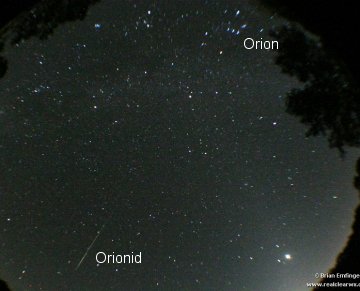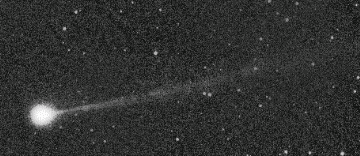 Where's Saturn? Is that a UFO--or the ISS? What's the name of that star? Get the answers from mySKY--a fun new astronomy helper from Meade. Where's Saturn? Is that a UFO--or the ISS? What's the name of that star? Get the answers from mySKY--a fun new astronomy helper from Meade. TONIGHT AT SUNSET: Here is one reason to go outside at the end of the day and look around: photo. Here's another: Tonight's crescent Moon and the planet Jupiter are hanging side-by-side in the sunset sky. It's a beautiful view--don't miss it! [sky map] EARLY ORIONIDS: This morning, Oct. 15th, a bright meteor raced out of the constellation Orion over Ozark, Arkansas, where photographer Brian Emfinger caught it in mid-flight: 
Photo details: Canon Digital Rebel XT, fisheye lens, ISO 1600, F3.5, 30 secs
That streak of light is very likely a piece of Halley's Comet. Every year in October, Earth passes through a stream of Halley's dusty debris, giving rise to the Orionid meteor shower. This year, the display is expected to peak on Oct. 21st, but some of the meteors may be arriving early. "My camera captured three more Orionids on Oct. 13th," says Emfinger, while Doug Zubenel reports seeing at least ten Orionids from the 24th annual Okie-Tex Star Party on Oct. 10th. Do early Orionids bode well for peak-night? There's one way to find out: Watch the sky during the dark hours before sunrise on Sunday, Oct. 21st. If 2007 is like 2006, observers can expect 20 to 50 Orionids per hour: sky map. COMET LONEOS: Comet LONEOS (C/2007 F1) is plunging toward the sun and solar heating is doing its work: pieces of the 8th-magnitude comet are boiling off. "We were surprised to see blobs moving in the tail," report Filipe Alves, Jan Lameer and Jose Ribeiro at the AstroQueyras Observatory in the French Alps. This 24-minute time-lapse movie shows the view through the observatory's 8-inch telescope on Oct. 12th: 
Comet LONEOS makes its closest approach to the sun just outside the orbit of Mercury on Oct. 29th. At that time it may become faintly visible to the unaided eye--a 4th magnitude fuzzball with an increasingly active tail. [ephemeris] [3D orbit] Meanwhile, the comet is a good target for mid-sized backyard telescopes--if you can point your 'scope low enough. "This comet is so close to the horizon, it is almost too low for my equipment," says astrophotographer Mike Holloway of Van Buren, Arkansas. "How low? I I had to ask my neighbor across the field to move his cows so they don't block the view. Well, maybe it's not quite that bad! I did manage to capture this image on Oct. 11th using a 5-inch refracting telescope." Astronomers, ready your telescopes: Oct. 17th is a good night to find Comet LONEOS as it passes the 3rd-magnitude star Muphrid in the constellation Bootes. Sky maps: Oct. 14, 15, 16, 17.
October 2007 Aurora Gallery
[September Aurora Gallery] [Aurora Alerts] | 
